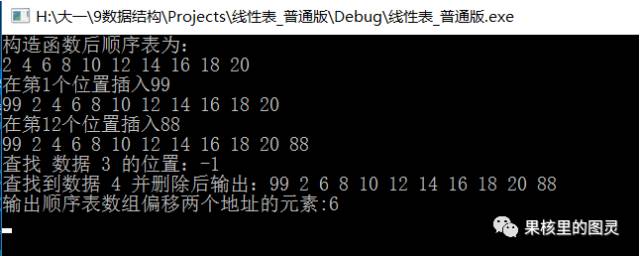


C/C++培训
达内IT学院
400-996-5531

代码开始前的闲谈
数据结构部分现在开始了,所用的书是 《数据结构》科技出版社 作者 吴陈 教授。
作者是我校的老师。感谢老师一学期的辛勤工作。由于课本是用 V C 6.0 写的。所以我这里用 vs 2015.。
包含的主要知识点:
1.C++模板类 友元函数的写法。
2.C++模板类 重载cout<< 的写法。
3.线性表的普通写法。
线性表的一般写法
先来张图证明一下我的代码没问题。。。(总是有眼神不好用的说我代码出问题,结果是他自己抄错了一些细节。)

“ 头文件:
#pragma once
#define MaxSize 100
#include<ostream>
#include<iostream>
using namespace std;
template<class T>
class LinearList;
template<class T>
ostream& operator<<(ostream & os, LinearList<T> & a);
template<typename T>
void PrintList2(LinearList<T> & a);
template<class T>
class LinearList
{
public:
LinearList();//无参数构造函数。
LinearList(T a[],int n);//n个数据的 构造函数。
~LinearList();//析构函数。
private:
T Data[MaxSize];
int Length;
public:
int GetLength();//获取线性表储存数据的个数。
T GetPos(int pos);//返回线性表的 第 pos 个数据。
void InsertObjInPos(T Obj, int pos);//在第 pos 个位置 插入Obj
T DeletePos(int pos);//删除第 pos 个位置的数据。
int Locate(T Obj);//查找 数据Obj 的位置。没有则返回 -1。
void PrintList1();
friend ostream& operator<< <>(ostream & os,LinearList<T>& a);//重载输出线性表
friend void PrintList2<>(LinearList<T> & a);//友元函数输出顺序表。
T SetPosToObj(int pos, T Obj);//把第 pos 个位置的数据改成 Obj
T *ToFirstAdd();//返回线性表首地址
void SetLength(int len);//设置线性表长度。
};
template<typename T>
ostream& operator<<(ostream & os, LinearList<T> & a)
{
for (int i = 0; i < a.Length;i++)
{
os << a.Data[i]<<" ";
}
os << '\n';
return os;
}
template<typename T>
void PrintList2(LinearList<T> & a)
{
for (int i = 0; i < a.Length;i++)
{
std::cout << a.Data[i]<<" ";
}
std::cout << '\n';
} “ cpp文件:
#include "stdafx.h"
#include "LinearList.h"
template<typename T>
LinearList<T>::LinearList()
{
Length = 0;
}
template<typename T>
LinearList<T>::LinearList(T a[], int n)
{
this->Length = n;
for (int i = 0; i < n; i++)
{
this->Data[i] = a[i];
}
}
template<typename T>
LinearList<T>::~LinearList()
{
Length = 0;
}
template<typename T>
int LinearList<T>::GetLength()
{
return this->Length;
}
template<typename T>
T LinearList<T>::GetPos(int pos)
{
return this->Data[pos];
}
template<typename T>
void LinearList<T>::InsertObjInPos(T Obj, int pos)
{
if (pos > Length + 1||pos<1)
{
throw "InsertObjInPos error! And mostly the position is too long or too short";
return;
}
this->Length++;
for (int i = Length - 1; i >= pos; i--)
{
this->Data[i] = this->Data[i - 1];
}
this->Data[pos - 1] = Obj;
}
template<typename T>
T LinearList<T>::DeletePos(int pos)
{
if (pos<1 || pos>this ->Length)
{
throw "DeletePos error and mostly the position is wrong";
}
T temp = this->Data[pos - 1];
for (int i = pos - 1; i < Length-1; i++)
{
this->Data[i] = this->Data[i + 1];
}
Length--;
return temp;
}
template<typename T>
int LinearList<T>::Locate(T Obj)
{
int pos = -1;
for (int i = 0; i < Length; i++)
{
if (this->Data[i] == Obj)
{
//return i+1;
pos = i + 1;
return pos;
}
}
return pos;
}
template<typename T>
void LinearList<T>::PrintList1()
{
for (int i = 0; i < this->Length; i++)
{
std::cout << this->Data[i]<<' ';
}
std::cout << endl;
}
template<typename T>
T LinearList<T>::SetPosToObj(int pos, T Obj)
{
if (pos<1 || pos>this - Length+1)
{
throw "DeletePos error and mostly the position is wrong";
}
if (pos == Length + 1)
{
Length++;
this->Data[pos - 1] = Obj;
}
this->Data[pos - 1] = Obj;
return T();
}
template<typename T>
T * LinearList<T>::ToFirstAdd()
{
return this->Data;
}
template<typename T>
void LinearList<T>::SetLength(int len)
{
this->Length = len;
} “ 主函数:
// 线性表_普通版.cpp : 定义控制台应用程序的入口点。
//
#include "stdafx.h"
#include"LinearList.cpp"
#include<iostream>
using namespace std;
int main()
{
int test[10] = { 2,4,6,8,10,12,14,16,18,20 };
LinearList<int> a(test,10);
std::cout << "构造函数后顺序表为:" << endl;
a.PrintList1();//第一种方法输出。
std::cout << "在第1个位置插入99" << endl;
a.InsertObjInPos(99, 1);
PrintList2(a);//第二种方法输出。
std::cout << "在第12个位置插入88" << endl;
a.InsertObjInPos(88, 12);
cout << a;//重载输出。
std::cout << "查找 数据 3 的位置:" << a.Locate(3) << endl;
std::cout << "查找到数据 4 并删除后输出:";
a.DeletePos(a.Locate(4));
cout << a;//再来一个重载输出。其实重载输出还有其他的写法。我这里用了 <> 来写。下一章我会用其他的写法实现重载。
cout << "输出顺序表数组偏移两个地址的元素:";
std::cout << a.ToFirstAdd()[2]<<endl;
getchar();
return 0;
}
本文内容转载自网络,本着分享与传播的原则,版权归原作者所有,如有侵权请联系我们进行删除!
Copyright © Tedu.cn All Rights Reserved 京ICP备08000853号-56  京公网安备 11010802029508号 达内时代科技集团有限公司 版权所有
京公网安备 11010802029508号 达内时代科技集团有限公司 版权所有